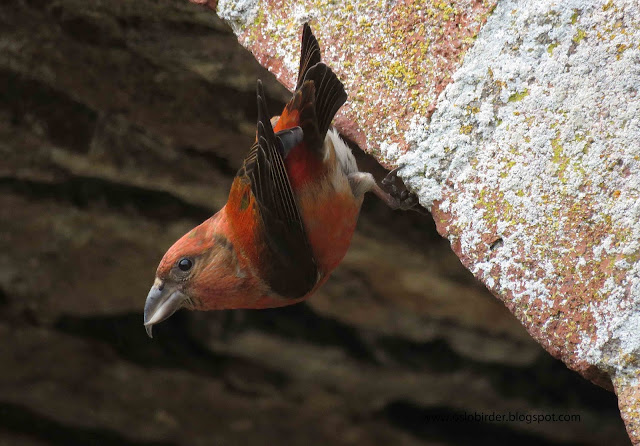April
 |
| I have concluded that this male harrier that I saw at Årnestangen is a Pallid x Hen Harrier which is the first record of an adult male in Norway although there have been a few autumn juveniles |
 |
| Twite (bergirisk) pass through Maridalen in the spring |
 |
| huge numbers of Common Crossbills (grankorsnebb) bred in Southern Norway in 2016 as a result of the a large crop of spruce crones. In Maridalen they could often be seen licking salts from bricks |
 |
| this Long-tailed Tit probably bred in Maridalen and the dark head markings show it not to be of the regular scandinavian race but rather an intergrade with the continental race |
 |
| highlight of the year was finding this Short-toed Lark (dverglerke) in Maridalen |
 |
| closely followed by this 2nd summer Med Gull |
 |
| these Shore Larks (fjelllerke) were only the second record in Maridalen |
 |
| this male Steller's Eider in the company of a Common Eider was an amazing record in the inner Oslofjord |
 |
| the breeding Kingfishers in urban Sandvika |
 |
| April is always a good time for finding Green-winged Teals in Southern Norway although this was the only one I saw in 2016 |
 |
| a most unexpcted find in Maridalen was a pair of Little Ringed Plovers (dverglo) that favoured a ploughed field for a couple of days (the same field that had held Short-toed and Shore Larks earlier) |
May
 |
| My best ever views of Hazel Grouse (jerpe) - a species which I now have a number of sites for in the forests around Oslo |
 |
| breeding Black Woodpecker in Maridalen |
 |
| a fine male Bluethroat (blåstrupe) in Maridalen - it is not often one sees spring migrants |
 |
| singing Wryneck (vendehals) in Maridalen |
 |
| my first Dotterel (boltit) for Akershus |
 |
| Icterine Warblers (gulsanger) are one of the last migrants to arrive |
 |
| a pair of Red-breasted Flycatchers (dvergfluesnapper) returned to Sørkedalen in 2016 but then promptly vanished |
 |
| Sørkedalen also hosted breeding Red-backed Shrikes (tornskate) |
 |
| this Wood Watbler (bøksanger) is a rare example lacking most of the yellow tones and thus resembling a Bonelli's Warbler |
 |
| Common Rosefinch (rosenfink) is now a regular breeder around Oslo |
 |
| a very scarce migrant Broad-billed Sandpiper (fjellmyrlper) at Årnestangen |
 |
| Østensjøvannet hosted this smart 2nd summer Little Gull (dverglerke) for a few days amongst the breeding Black-headed Gulls |
June
 |
| my annual early summer trip to Hedmark included a trip over the border into Sweden where with the help of GPS tags I was able to locate some of the Scottish Taiga Bean Geese on their breeding grounds |
 |
| Hedmark has lots of exciting breeding birds including Ortolan (hortulan) |
 |
| Siberian Jay (lavskrike) |
 |
| Three-toed Woodpecker (tretåspett) |
 |
| Ural Owl (slagugle) |
 |
| and the last remaining Rustic Buntings (vierspurv) in Norway |
 |
| this youngster being possibly the only known one this year |
 |
| mum |
 |
| and Red-necked Phalaropes (svømmesnipe) |
 |
| back home I had my best ever view of Corncrake (åkerrikse) |
 |
| obliging breeding Long-eared Owls (hornugle) |
 |
| twitched my first Norwegian Terek Sandpiper |
 |
| and enjoyed breeding Marsh Warblers (myrsanger) in Maridalen |















